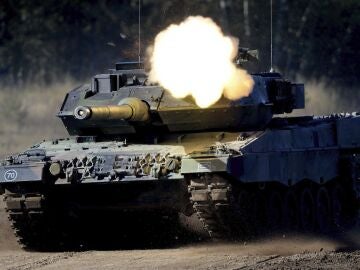
Any decision that Germany makes about its participation in a war has been done since the extreme prudence, for political reasons and also because of its historical past. But in recent months, with the Russian invasion of Ukraine, the demand for decisions has raised the pressure, both with its European partners and internally with its government partners. Social democrats, greens and liberals have different opinions on the role to be played by Germany.
The possible shipment of Leopard 2 tanks to Ukraine It is the last controversy on the table and in the last hours there has been a change. Internal pressures have passed from the Bundestag and its deputies to Scholz’s own cabinet. And not privately, but showing the discrepancies before the media, in public. A) Yes, the foreign minister, the green Annalena Baerbock, he explained in an interview with French television LCI, that his country would not oppose another country sending the tanks. However, the reality is that it is not a decision that depends on his ministerial portfolio.
Poland has made its request official, submitting to Germany a request for the transfer of Leopard 2 tanks to Ukraine. Meanwhile, Chancellor Scholz resists the pressure. The last thing that has transpired are the words of the Defense Minister, Boris Pistorius, who has said that the decision will be made in the “next few days”, although he has marked as the first step the preparation of an inventory of the currently available cars. Once this inventory is done, and “if the yes is given”, the issue can be resolved in a matter of days, Pistorius said in an interview with the ZDF chain, hours before meeting with NATO Secretary General Jens Stoltenberg. .
But beyond the internal political disputes, the history of Germany is also a guest actor in making any decision in a war conflict. In the memory of the Germans, the memory of the Nazi tanks devastating half of Europe during World War II is still very alive. This image has always made German governments in recent decades very prudent when making any decision about their participation or provision of aid in conflict zones. However, it seems that Russia’s invasion of Ukraine has marked a before and after. And it is that since the beginning of the war, Germany has supplied, among others, the IRIS-T anti-missile system, the MLRS rocket launcher systems and the Patriot missile battery.
From the outside, those who exerting more pressure are the Baltic countries and those bordering Russia. “We have been talking about this issue for a long time and it is important that Ukraine immediately receives the material it needs,” says Finnish Foreign Minister Pekka Haavisto.
The Latvian minister, Edgars Rinkevics, is more emphatic, who believes that for Germany, “being a great country also carries a lot of responsibility”, while his Lithuanian counterpart, Gabrielius Landsbergis, actually calls for “overcoming the fear of defeating Russia”. “Germany is the motor of Europe, a great partner in the EU, and also has a particular responsibility, I hope there is not some ambivalence in that decision” on the tanks, added Estonian minister Urmas Reinsalu.
“Aerating alleged divisions when right now all Europeans are united in supporting Ukraine does not make Ukraine’s task any easier because unity is a very important part of how Ukraine and Europe are meeting the challenge of (the Russian president) Vladimir Putin”, pointed out the Spanish Foreign Minister, José Manuel Albares.
What distinguishes Leopard tanks?
Ukraine’s demand for a greater rearmament of its Armed Forces now has as its main message the request to allies for tanks, particularly the Leopard 2, German-made equipment with which Ukrainian forces hope to contain potential Russian advances in the eastern part of the country.
The Leopard counts as the main element a 120-millimeter gun capable of firing at targets several thousand meters away. The German Armed Forces estimate the combat distance at 5 kilometers within the technical specifications of this tank, which is available (in different versions) in more than a dozen countries.
The Leopard 2 has capacity for four crew members and has a thermal display device, which would facilitate its use during the night. It also has the capacity to overcome water up to four meters deep.
This type of equipment it was designed in its day as a counterweight to the Russian tank T-90, deployed by Moscow in the current military offensive on Ukrainian territory. It has already been used in combat scenarios, such as Syria or Afghanistan, and Ukraine now wants it to reinforce a flank in which it feels particularly weak against Russia.
The Leopard also has the particularity of being of european manufacturingwhich facilitates its potential dispatch to the combat front, as well as the maintenance and repair of the equipment.
The position of Germany, which has already provided IRIS-T and Patriot defense systems to Ukraine, is key in the debate on the arrival of Leopard tanks. Not only does the delivery of its own cars depend on its position, but Berlin can also limit other governments from deciding to help kyiv on their own, by virtue of a veto on exports to third countries.
Source: Lasexta
Mario Twitchell is an accomplished author and journalist, known for his insightful and thought-provoking writing on a wide range of topics including general and opinion. He currently works as a writer at 247 news agency, where he has established himself as a respected voice in the industry.












